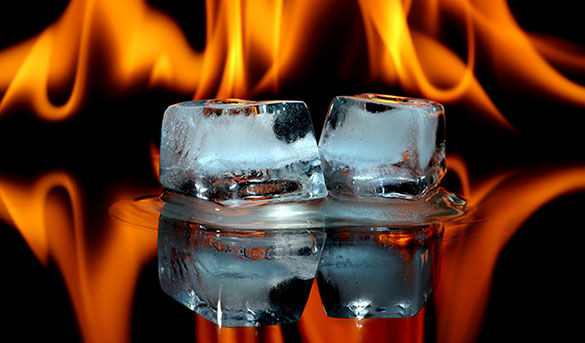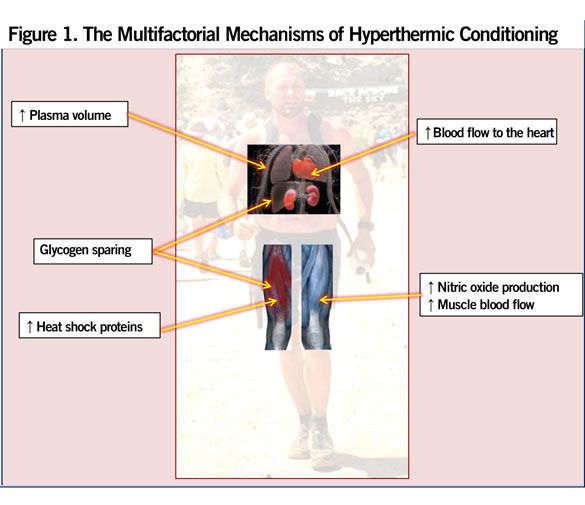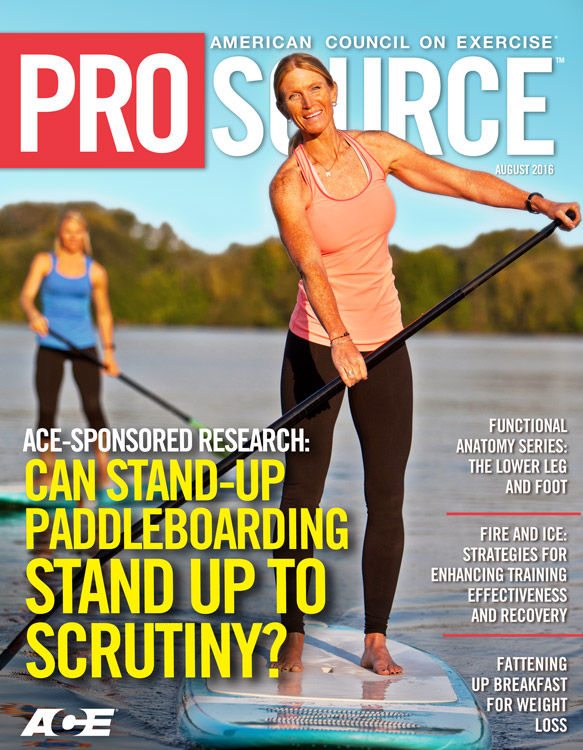
Recent research has shown that both heat and cold applications can benefit overall training and facilitate a more rapid recovery. Here is a practical, step-by-step guide on how to use fire and ice to enhance your clients’ training effectiveness and recovery.
How Does Hyperthermic Conditioning Help Improve Performance?
Repeated exposure to hot and/or humid environmental conditions, which elicits an increase in both core temperature and sweating, leads to numerous physiological adaptations that ultimately reduce the deleterious effects of heat stress. This process is known as heat acclimatization or hyperthermic conditioning. The mechanisms of hyperthermic conditioning are multifactorial (Figure 1), and not only improve heat tolerance, but have the capacity to improve exercise performance as well.
Increased Plasma Volume
One of the hallmark adaptations to heat stress is an increase in plasma volume (see Figure 1). Indeed, after only three to four days of acute heat exposure, plasma volume typically is increased about 5 to 15 percent (Périard et al., 2016). In turn, it is well known that increased plasma volume is an important factor mediating improvements in maximal oxygen uptake (i.e., VO2max). Given the robust relationship between VO2max and endurance performance, an increase in plasma volume signals an improved capacity for performance in endurance-related events.
Increased Nitric Oxide
Heat exposure leads to marked elevations in the potent vasodilator molecule known as nitric oxide (Krause et al., 2015). Increased concentrations of nitric oxide results in increased blood flow to both the heart and skeletal muscle (see Figure 1). Increased blood flow to the heart results in a lower heart rate for the same exercise workload, which makes it possible to exercise for longer periods in hot conditions. Increased blood flow to exercising skeletal muscle increases the delivery of various nutrients, including glucose, esterified fatty acids and, most importantly, oxygen. It is important to highlight that improved delivery of glucose to skeletal muscle during exercise will spare liver and muscle glycogen by 45 to 50 percent (see Figure 1). The sparing of muscle glycogen is associated with the enhanced ability to perform highly intense exercise (King et al., 1985).
Increased Heat Shock Proteins
Exposure to heat stress has been shown to increase the concentration of heat shock proteins (see Figure 1). Heat shock proteins scavenge free radicals, decrease damage to proteins from exercise-induced oxidative stress and increase antioxidants. Overall, these adaptations contribute to a net increase in protein synthesis, which will favor muscle hypertrophy.

Contemporary research has focused on how exercise, in conjunction with hyperthermic conditioning, can be used to improve overall exercise performance and recovery. Here are three studies that illustrate how adding some “fire” to a client’s workout can improve training effectiveness.
1. Add sauna use to the post-exercise routine.
A group of New Zealand researchers (Scoon et al., 2007) had competitive male distance runners take 30-minute sauna baths at 194° F (~90° C) immediated post-workout on four days of the week for a three-week training period. It was found that, relative to control, sauna bathing increased run time to exhaustion by 32 percent. It was also found that plasma and red-cell volumes increased by 7.1 percent and 3.5 percent respectively, after sauna relative to control.
Practical Recommendation: The researchers concluded that three weeks of post-exercise sauna bathing produced a meaningful enhancement of endurance performance that would be equivalent to an approximately 2 percent improvement in 5K run time. It is suggested that sauna bathing that can be tolerated for 30 minutes immediately after a training run provides an additional training stimulus. Health and fitness professionals should take care to limit this recommendation to healthy individuals. Individuals with chronic conditions should first consult with their physicians prior to sauna use or other heat therapy.
2. Exercise training with a sauna suit improves performance.
Recently, a group of American researchers investigated the combined effects of exercise training with a sauna suit on various markers of performance and heat tolerance. Van De Velde and colleagues (2016) recruited 12 men to complete six weeks of exercise training with a Kutting Weight® sauna suit. The training program consisted of cycle ergometry exercise for five days per week for 30 minutes per day at moderate-intensity exercise (55 to 60 percent heart-rate reserve). The 150 minutes per week of exercise training with the sauna suit were substituted for preexisting exercise training for each participant in a manner that resulted in overall exercise training volume and intensity remaining unchanged throughout the six-week intervention period. The researchers reported significant improvements in VO2max (+8.5 percent), metabolic threshold (+8.4 percent) and peak power output (+3.8 percent). Additionally, the researchers demonstrated that training with a sauna suit improved heat tolerance, as evidenced by a 61.7 percent improvement in exercise time to fatigue in a simulated hot environment.
Practical Recommendation: The researchers concluded that their findings provide preliminary evidence that supports the use of a practical and portable sauna suit as a form of thermal treatment to enhance endurance-related performance and heat tolerance. Health and fitness professionals can suggest to healthy clients that moderate-training exercise training with a sauna suit may provide an additional training stimulus.
3. Sauna use triggers a massive release in growth hormone.
A group of Finland researchers (Leppäluoto et al., 1986) exposed 10 healthy men to a sauna at 176° F (80° C) for one hour twice a day for seven days. They found that there was a massive 16-fold increase in growth hormone levels. It has long been established that growth hormone plays an important biochemical role in determining the absolute changes in muscle size, which results from resistance training (Goldberg and Goodman, 1969).
Practical Recommendation: Sauna use promotes a substantial increase in growth hormone concentrations. The well-known relationship between growth hormone and muscle hypertrophy means exercise professionals may promote sauna use as a natural means for clients to improve growth hormone levels to help meet individual resistance-training goals.
The Chilling Effects of Ice on Recovery
Cold water immersion (CWI) is frequently used as a viable method to recover from an exercise-training session or competitive performance because it is believed to aid in lessening muscle fatigue and soreness, and, ultimately, reducing the overall time needed for recovery (Versey, Halson and Dawson, 2013). The exact mechanisms involved in aiding in recovery are not well understood because the use of CWI in investigations is a relatively newer topic of concern. However, a recent review of the possible physiological mechanisms associated with CWI revealed that the major factors are the effects from the cold water and the added hydrostatic pressure (Ihsan, Watson and Abbiss, 2016). The coolness of the water helps to decrease core and skin temperature, which increases the body’s heat-storage capacity, causes peripheral vasoconstriction and increases central blood volume. The increased vasoconstriction may also aid in mitigating the inflammatory response in the tissues affected by the training bout or performance. The added hydrostatic pressure to the body is thought to aid in increasing the osmotic gradient and allows for a better “flushing” of metabolic byproducts.
In both competitive and recreational athletes, there is considerable interest in implementing practices to decrease recovery time while maintaining performance over an extended period of time (e.g., throughout a season, during tournament play or between training sessions). Due to the previously mentioned mechanisms, it is believed that CWI can help decrease body temperature, lower resting heart rate, reduce peripheral edema and inflammation, and provide an analgesic effect that helps decrease perceived muscle soreness. Currently, there are no set guidelines for implementing CWI. For example, temperatures of CWI in the literature vary from 41 to 68° F (5 to 20° C), with immersion times reported between five and 20 minutes and shorter repeated times (one to five minutes) interspersed with one to two-and-a-half minutes outside of the water (Versey, Halston and Dawson, 2013). However, implementing CWI appears to provide a small, but potentially important improvement in overall recovery time (Poppendieck et al., 2013).
Here are three key studies investigating CWI effects on delayed onset muscle soreness (DOMS), impact on fatigue rates during tournament play of a traditional sport (soccer), and improvements in performance in a non-traditional sport (rock climbing).
1. CWI helps lessen the effects of DOMS.
Vaile and colleagues (2008) investigated the effects of CWI (59° F/15° C), hot water immersion (100° F/38° C), and contrast water therapy (59° F/15° C for one minute and 100° F/38° C for one minute) compared to passive recovery after a muscle-damaging protocol (seven sets of 10 eccentric repetitions on a leg-press machine). All hydrotherapy sessions lasted 14 minutes. Researchers concluded that both CWI and contrast water therapy were successful in mitigating the physiological and functional factors associated with DOMS, with improvements in recovery of isometric and dynamic power and lessened edema.
2. Perceptual fatigue is reduced with CWI.
To understand the effects of CWI on the physical performance of soccer players during tournament play, Rowsell et al. (2009) had high-performing male soccer players utilize CWI (50 ± 1.0° F/10 ± 0.5° C) or immerse themselves in thermoneutral water for five sessions of one minute in the water and one minute out of the water. The hydrotherapy sessions took place 20 minutes after each of the four matches on four consecutive days. Roughly 90 minutes before each match and 22 hours after the final match, measurements of physical performance testing, intracellular proteins and inflammatory markers were noted, and perceptual recovery measurements were recoded 22 hours after each match. Researchers concluded that there was no evidence of enhanced physical performance between matches when using CWI compared to thermoneutral water, but CWI did help to reduce the perception of fatigue and leg soreness between subsequent matches. While this study did not find any physiological markers of improvement, there was considerable psychological improvement toward recovery when CWI was used.
3. CWI reduces inflammation and provides an analgesic effect to help maintain performance.
A group of Belgian researchers (Heyman et al., 2009) investigated the effects of passive recovery, active recovery, electromyostimulation and CWI of the arms [three sessions of five minutes in the water (59 ± 2° F/15 ± 1° C) and two minutes out of the water] after a rock-climbing test (completion of a 6b route, on the French grading system, at an indoor climbing gym) to volitional exhaustion. Once the recovery methods were implemented, the athletes completed the same rock-climbing test to volitional fatigue. Researchers concluded that CWI allowed for the climbing performance to be preserved, indicating that CWI may be effective for recovery when repeating intense exercises. The authors suggested that CWI was successful in helping to maintain performance due to an analgesic effect and reduced inflammation in the forearms.
Caution Must Be Stressed When Implementing Cold Water Immersion
Even though a substantial number of studies point to the effectiveness of CWI, there are just as many indicating CWI may have no effect or a negative effect on performance. Emerging evidence is finding that CWI, as well as other methods thought to improve resilience and lessen the physiological stress (i.e., antioxidant supplementation; for more information, see Free Radicals, Antioxidants, and Exercise: A New Perspective), may be counterproductive to desired performance adaptations. Recently, Fr?hlich and colleagues (2014) examined the long-term effects of CWI after resistance training. In this study, the researchers investigated five weeks of the leg curl exercise with one leg undergoing CWI after training bouts. At the end of the study, it was found that the cooled leg exhibited a 1 to 2 percent reduction in training effects compared to the non-cooled leg. While these effects may be small, this could play a critical role in decreasing adaptations in a high-performance setting.
Similarly, Roberts et al. (2015) found that after a 12-week strength-training program, participants that utilized CWI had less strength and muscle mass gains than those who participated in active recovery. A subset of this study also found that CWI reduced the acute anabolic signaling pathways that regulate muscle hypertrophy. Therefore, if CWI immersion is used chronically, there may be smaller muscle strength and hypertrophy adaptations after strength training.
Based on the current literature, it appears the acute bouts of CWI to facilitate a quicker recovery may be feasible, but chronic use of CWI should be reconsidered to avoid lessening of training adaptations.
Application of Cold Water Immersion
Halson (2011) published considerations for practical applications of CWI. Among these considerations is to first determine whether CWI is a feasible mechanism for recovery and if it is truly needed. If CWI is deemed necessary for recovery, based on findings in the literature an effective approach is to immerse the full body (other than the head) in 50 to 59° F (10 to 15° C) water for 14 to 15 minutes. If the desired activity or performance involves high-intensity explosive exercise, CWI should not be implemented within 45 minutes of the start of the activity to ensure the temperature of the body is warm enough to effectively perform these movements (Versey, Halson and Dawson, 2013).
Because of the considerable variability seen in the efficacy of CWI, any proposed recovery methods utilizing CWI should be tested prior to performance or competition to ensure the individual will not adversely respond to the recovery methods.
References
Frohlich, M. et al. (2014). Strength training adaptations after cold water immersion. Journal of Strength and Conditioning Research, 28, 2628-2633.
Goldberg, A.L. and Goodman, H.M. (1969). Relationship between growth hormone and muscular work in determining muscle size. The Journal of Physiology, 200, 655-666.
Halson, S.L. (2011). Does the time frame between exercise influence the effectiveness of hydrotherapy for recovery? International Journal of Sports Physiology and Performance, 6, 147-159.
Heyman, E. et al. (2009). Effects of four recovery methods on repeated maximal rock climbing performance. Medicine & Science in Sports & Exercise, 41, 1303-1310.
Ihsan, M., Watson, G. and Abbiss, C.R. (2016). What are the physiological mechanisms for post-exercise cold water immersion in the recovery from prolonged endurance and intermittent exercise? Sports Medicine, 1-15.
King, D.S. et al. (1985). Muscle metabolism during exercise in the heat in unacclimatized and acclimatized humans. Journal of Applied Physiology, 59, 1350-1354.
Krause, M. et al. (2015). Heat shock proteins and heat therapy for type 2 diabetes: Pros and cons. Current Opinion in Clinical Nutrition and Metabolic Care, 18, 374-380.
Leppäluoto, J. et al. (1986). Endocrine effects of repeated sauna bathing. Acta Physiologica Scandinavica, 128, 467-470.
Périard, J.D. et al. (2016). Cardiovascular adaptations supporting human exercise-heat acclimation. Autonomic Neuroscience, 196, 52-62.
Poppendieck, W. et al. (2013). Cooling and performance recovery of trained athletes: A meta-analytical review. International Journal of Sports Physiology and Performance, 8, 227-242.
Roberts, L.A. et al. (2015). Post-exercise cold water immersion attenuates acute anabolic signaling and long-term adaptations in muscle to strength training. The Journal of Physiology, 593, 4285-4301.
Rowsell, G.J. et al. (2009). Effects of cold-water immersion on physical performance between successive matches in high-performance junior male soccer players. Journal of Sports Sciences, 27, 565-573.
Scoon, G.S. et al. (2007). Effect of post-exercise sauna bathing on the endurance performance of compmetitive male runners. Journal of Science and Medicine in Sport, 10, 4, 259-262.
Vaile, J. et al. (2008). Effect of hydrotherapy on the signs and symptoms of delayed onset muscle soreness. European Journal of Applied Physiology, 102, 447-455.
Van de Velde, S.S. et al. (2016). Effects of exercise training with a sauna suit on cardiovascular health: A proof-of-concept study. International Journal of Research in Exercise Physiology, 11, 1-10.
Versey, N.G., Halson, S.L. and Dawson, B.T. (2013). Water immersion recovery for athletes: Effect on exercise performance and practical recommendations. Sports Medicine, 43, 1101-1130.









